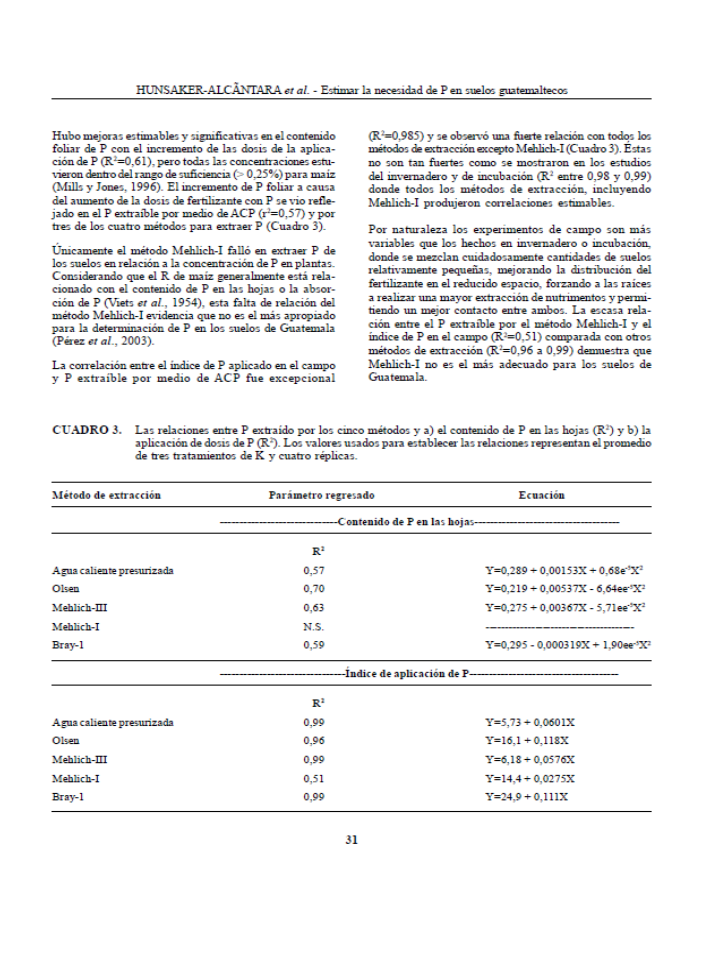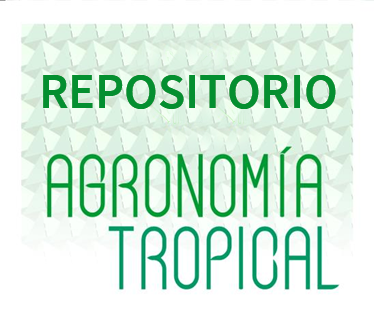Alternativas al método de extracción Mehlich-I para estimar la necesidad de P en suelos guatemaltecos
Resumen
El costo e inaccesibilidad para el análisis de suelo en países desarrollados y en vías de desarrollo reducen la efectividad de fertilizantes, y fondos monetarios inadecuados promueven el uso de métodos de análisis de suelo con validación mínima. De los métodos con potencial para la extracción y análisis de P, sólo cinco se muestran promisorios, pero todos necesitan más investigación. El estudio se realizó en 26 campos de agricultores (en localidades múltiples), así mismo, tres estudios con tratamientos de fertilizantes idénticos (incubación de suelos, invernadero y campo). En las localidades múltiples, los métodos Agua Caliente Presurizada (ACP) y Olsen se unificaron positivamente al rendimiento de maíz (r=0,60 y 0,75, respectivamente), pero se encontraron relaciones negativas para los métodos Mehlich-I y Bray-1 (r=-0,83 y -0,74, respectivamente). En el invernadero, el rendimiento, la concentración de P en tejidos vegetativos y la absorción total de P fueron efectivamente estimadas en los cinco métodos. En el campo controlado, el rendimiento no mejoró con la aplicación de P, aunque los contenidos de P en tejidos foliares se unieron al P extraíble para todos los métodos excepto el Mehlich-I (R2 de 0,57-0,70). El P extraíble se afectó en menor medida con la aplicación de P y Mehlich-I (R2 de 0,51 comparado 0,96-0,99 con otros métodos). En general, ACP y Olsen resultaron similares y efectivos, Bray-1 y Mehlich-III fueron menos consistentes y Mehlich-I fue el menos consistente de los métodos de extracción estudiados
Descargas
Citas
• Bray, R. H. and L. T. Kurtz. 1945. Determination of total organic and available forms of phosphorus in soils. Soil Sci. 59:39-45.
• Bundy, L. G., T. W. Andsraski and J. M. Powell. 2001. Management practice effects on phosphorus losses in runoff in corn production systems. J. Environ. Qual. 30:1 822-1 828.
• Chase, C., M. Duffy, J. Webb and R. Voss. 1991. An economic assessment of maintaining high phosphorus and potassium soil test levels. Am. J. of Alt. Ag., 6:83-86.
• Chien, S. H., F. Adams, F. E. Khasawneh and J. Henao. 1987. Effects of combinations of triple superphosphate and a reactive phosphate rock on yield and phosphorus uptake by corn. Soil Sci. Soc. Amer. J. 51:1 656-1 658.
• Crane, K. S., B. L. Webb, P. S. Allen and V. D. Jolley. 2006. Simplified soil analysis procedure for use in small-scale agriculture. Commun. Soil. Sci. and Plant Anal. 37:993-1 010.
• Enwezor, W. O. 1977. Soil testing for phosphorus in some Nigerian soils: I. Comparison of methods of determining available phosphorus in soils of Southeastern Nigeria. Soil Sci. 123:48-53.
• Fauchére, J. M. F. 2000. Technological gap for maize (Zea mays L.) cultivation in the Polochic watershed of Guatemala. Unpublished Doctor of Natural Sciences. Swiss Federal Institute of Technology, Zurich.
• Fixen, P. E. and J. H. Grove. 1990. Testing soils for phosphorus. In: R.L. Westerman (ed.) Soil testing and plant analysis. SSSA, Madison, WI. p. 141-180. Disponible es: from http://apps.fao.org
• Havlin, J. L., J. D. Beaton, S. L. Tisdale and W. L. Nelson. 2005. Soil Fertility and Fertilizers an Introduction to Nutrient Management (Seventh ed.). New Jersey: Prentice-Hall, Inc.
• Heckman, J. R., W. Jokela, T. Morris, D. B. Beegle, J. T. Sims, F. J. Coale, S. Herbert, T. Griffin, B. Hoskins, J. Jemison, W. M. Sullivan, D. Bumbla, G. Estes and W. S. Reid. 2006. Soil test calibration for predicting corn response to phosphorus in the Northeast USA. Agron. J. 98:280-288.
• Hunsaker-Alcântara, H. M., V. D. Jolley, B. L. Webb, P. S. Allen, R. D. Horrocks and M. L. Bueso Campo. 2007. Predicting maize yield, nutrient concentration and uptake in P and K fertilized soils: Pressurized hot water and other alternatives to Mehlich I extraction in Guatemala soils. Commun. Soil. Sci. Plant Anal. 38:1 815-1 839.
• Johnson, C. M. and A. Ulrich. 1959. II. Analytical Methods for Use in Plant Analysis. Calif. Agric. Exp. Stn. Bull. 766:30-33.
• López, M. R. F. 2002. El cultivo del maíz en Guatemala, una guía para su manejo agronómico. Inst. Cienc. Tecnol. Agric. 1:45.
• Mallarino, A. P. and A. M. Blackmer. 1992. Comparison of methods for determining critical concentrations of soil test phosphorus for corn. Agron. J. 84:850-856.
• Mehlich, A. 1984. Mehlich 3 soil test extractant: A modification of Mehlich 2 extractant. (Extractor de prueba de suelo Mehlich 3: Una modificación al extractor Mehlich 2) Commun. Soil. Sci. Plant Anal. 15:1 409-1 416.
• Mills, H. A. and J. B. Jones Jr. 1996. Plant Analysis Handbook II. (Manual de Análisis de Plantas II) Athens, Georgia: Micro Macro Publishing, Inc.
• Murphey, J. and J. P. Riley. 1962. A modified single solution method for the determination of phosphate in natural waters. Anal. Chim. Acta 27:31-36.
• Olsen, S. R., C. V. Cole, F. S. Wantanabe and L. A. Dean. 1954. Estimation of available phosphorus in soils by extraction with sodium bicarbonate. U.S. Department of Agriculture. Cir. 939, U.S. Gov. Print. Office, Washington, DC.
• Pérez, O., M. Melgar and I. Lazcano-Ferrat. 2003. Phosphorus fertilization and phosphorus-extraction method calibration for sugarcane soils. Better Crops Int. 17:26-29.
• Pilbeam, C. J., P. J. Gregory, B. P. Tripathi and R. C. Munankarmy. 2002. Fate of nitrogen-15-labelled fertilizer applied to maize-millet cropping systems in the mid-hills of Nepal. Biol. Fertil. Soils. 35:27-34.
• Ramírez, R. 1981. Nutrición del maíz en Venezuela. IV. Valores Standard y adecuados de nitrógeno, fósforo, potasio, calcio y magnesio para interpretación de análisis foliar en maíz. Agronomía Trop. 30:125-133.
• Ramírez, R., J. Tenías, L. C. de Silva, T. Rodríguez y A. Chirinos. 1989. Calibración de cuatro métodos de análisis de suelo con la respuesta del maní a la fertilización con fósforo. Agronomía Trop. 39:5-21.
• Raun, W. R. and H. J. Barreto. 1995. Regional maize grain yield response to applied phosphorus in Central America. Agron. J. 87:208-213.
• Rehm, G. W. and J.A. Lamb. 2004. Impact of banded potassium on crop yield and soil potassium in ridge-till planning. Soil Sci. Soc. Am. J. 68:629-636.
• Ryan, J., G. Estefan and A. Rashid. 2001. Soil and plant analysis laboratory Manual International Center for Agriculture Research in the dry area (2nd ed.). Aleppo, Syria.
• Saín, G. and J. Martínez. 2004. Adoption and use of improved maize by small-scale farmers in Southeast Guatemala. México: CYMMYT. Working Paper 99-04:1-25.
• Shiffler, A. K., V. D. Jolley, J. E. Christopherson, B. L. Webb and V. A. Habey. 2005. Pressurized hot water and DTPA-sorbitol as viable alternatives for soil boron extraction. II. Correlation of soil extraction to responses of boron-fertilized alfalfa. Commun. Soil. Sci. Plant Anal. 36:2 189-2 207.
• Stewart, W. M., D. W. Dibb, A. E Johnston and T. J. Smith. 2005. The contribution of commercial fertilizer nutrients to food production. Agron. J. 97:1-6.
• Ussiri, D. A., P. N. S. Mnkeni, A. F. MacKenzie and J. M. R. Semoka. 1998. Soil test calibration studies for formulation of phosphorus fertilizer recommendations for maize in Morogoro District, Tanzania. II. Estimation of optimum fertilizer rates. Commun. Soil. Sci. Plant Anal. 29:2 815-2 828.
• Viets, F. G. Jr., C. E. Nelson and C. L. Crawford. 1954. The relationships among corn yields, leaf composition and fertilizers applied. Soil Sci. Soc. Am. Proc. 19:297-301.





